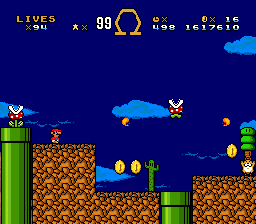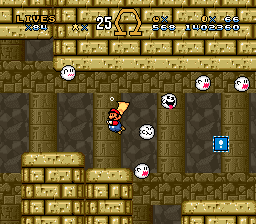Super Mario Omega
Higsby | 2009 | 100 Exits | Download Link


Super Mario Omega is a classic old-school romhack created between 2007 and 2009. Featuring exactly 100 exits over eight worlds, it is one of the larger solo author hacks (the readme file proudly states that every single available sublevel was edited in some way). The hack was released right around the time the technology to insert tracks of custom music became available on the broader SMW romhacking scene. Listening to these old ports today, roughly 15 years after the fact, feels a bit quaint, as these early pieces often sound somewhat tinny and more often than not feature blatantly wrong notes and generally unfitting instruments. While I wouldn’t call them good, I do admit that I feel a bit of nostalgia whenever I hear them. Besides these custom songs, the hack also features custom background, foreground, and sprite graphics, but is otherwise completely vanilla (meaning there are no custom sprites or ASM gimmicks). The level design is on the traditional side too, with a heavy emphasis on finding secrets. These secrets mostly consist of finding dragon coins and one-ups in the early game, but as the game goes on, you find yourself hunting for secret exits and even midway points too. As the hack progresses, the length of the levels slowly increases, and there are even a couple of very challenging marathon stages at the end of the special world. Overall though, even by the end of the hack the difficulty never got too out of hand, as there are generally enough powerups around to somewhat mitigate the length of the later stages.


While the hack was widely praised when it was released, I unfortunately don’t think it stood the test of time particularly well, at least compared to some other hacks of the same era of SMW hacking. For one thing, the levels seem overly saturated with enemy sprites, and it doesn’t feel like a lot of care and thought was put into the placement of each individual one. While playing the hack, I really got the feeling that the author placed the foreground tiles first, and simply added the sprites later to fill in the empty space. While that is not necessarily a bad way to design a level, generally speaking it heightens the possibility of the player being put in awkward spots unforeseen by the author. It also adds to the feeling that the levels end up resembling each other, since no individual obstacles or setups ever stood out in my memory. Couple that with the fact that the individual levels of each world also often feature the exact same background and foreground graphics, as well as the same music and enemy sprites, and they really start to blur together after a while. Thinking about it, with the exception of the special world, no level really has any individuality or unique identity.
As I mentioned above, the level design largely seems to focus on finding secrets. While I had completely given up on collecting the dragon coins early on during my playthrough, I did at least want to find every secret exit. In the end, I’m kind of in two minds about them. Some are genuinely pretty clever: For example, there’s an autoscroller where you need to find a hidden level entrance to manipulate the speed of the camera’s movement, and there’s a spotlight level where you need to backtrack to find a passage that you couldn’t see before. While these secrets might not sound incredibly creative written out like that, I appreciate how the creator made the vanilla mechanics interact with the level layout. On the other hand, other secret exits involved searching through giant mazes of identical looking sublevels, walking through hidden passages past seemingly solid foreground tiles, and in one particularly memorable case, completely replaying a 10 minute long gauntlet level, only to walk in one direction instead of the other before the goalpost. Needless to say, I did not particularly enjoy those moments.
All in all, I can’t really say I’d recommend this hack. While it had its moments, in my opinion it just wasn’t interesting enough to warrant its extended playtime. I suppose at the time this hack was released, people were generally playing these sorts of games with save states and rewinds, which would mitigate a lot of the issues I had with it. Looking at the hack from today’s perspective, I do find it interesting that as time has moved on, the heavy focus on finding secrets displayed in this hack has somewhat fallen out of fashion. With the advent of kaizo hacks, secret exits have become rarer and rarer, and even long standard hacks released nowadays have way fewer of them than they used to. I suppose if playing through this hack has taught me anything, it’s that hiding a secret exit in a meaningful and interesting way is a lot harder than it may seem.